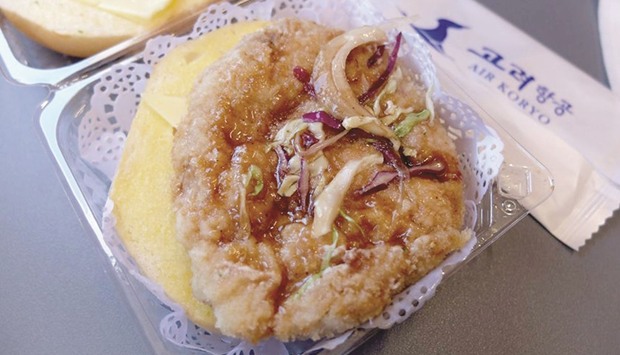The burger is always served cold, and always on a paper doily. Inside the bun is a piece of unidentified meat, a slice of processed cheese, a dash of shredded cabbage or a lonely lettuce leaf, and a dollop of sweet, brown sauce.
The “Koryo Burger” is featured in countless Instagram feeds and online reviews, not many of them complimentary. It has “gained cult status among passengers,” the British tabloid Daily Mail reported in 2015. Many wonder: Why a burger? What’s with the doily? What exactly is that meat?
But what if the West’s fascination with the Koryo Burger says less about the Koryo Burger than it does about the West?
The burger is “huge” in terms of public fascination, said Simon Cockerell, General Manager of the Beijing-based travel company Koryo Tours. “It’s something that people are absolutely blown away by. And it’s a piece of meat between two buns.” (Koryo refers to an old Korean dynasty; the two companies are unrelated.)
“I think it’s just the incongruity of having a burger on a quote-unquote ‘Communist’ plane,” said Cockerell, who has visited North Korea 161 times in the last 15 years. “But what else would they serve? You can’t give everyone a bibimbap (a Korean mixed rice dish), and serving kimchi on a plane would be horrifying.
“I think it’s just that North Korea, to tourists, is so inherently sinister and funny at the same time,” Cockerell said. “That ‘oh, my God, it’s a burger!’ — that’d be an absurd reaction on any other airline. But on Air Koryo, it’s a normal thing to do.”
The meat is chicken, he said. A man who picked up the phone at Air Koryo’s Beijing office confirmed that the airline “normally” serves burgers. He could not confirm the type of meat.
From 1994 to 1998, North Korea was ravaged by famine. Hundreds of thousands of people starved to death, according to best estimates. People ate bark and leaves to survive.
Although malnutrition remains common in North Korea, starvation is now rare. Since the Communist country’s public food distribution system collapsed in the mid-1990s, its citizens — with the state’s tacit approval — have turned to the gray market to survive. Supermarkets have proliferated, as have restaurants. Some sell Western meals.
“If you have a growing capitalist economy, somebody is buying jets and diamonds, and somebody is eating a nice protein-rich meal every day,” said Andrei Lankov, a North Korea expert at Kookmin University in Seoul. “Of course they are not buying diamonds constantly, and a protein-rich meal is still beyond the means of most people — even if the diet of the masses is improving fast.”
Zhao Bin, a businessman from the northeastern Chinese city of Shenyang, said that on his first visit to Pyongyang, in 2003, the electricity cut out every night. “The second time I went was almost 12 years later, and I think North Korea has developed a lot, and people’s lives have improved dramatically.”
Pyongyang’s restaurant offerings now include fried chicken, pizza, sushi — and – burgers. A burger, he said, costs about $1.50, and a 9-inch pizza costs less than $15. “My impression of having foreign food is that the service is exceptional, and the ingredients are all very fresh — unlike China, where there’s so much low-quality meat and vegetables.”
He gave the Koryo Burger high marks. “I think the meat they use is thicker and better than the stuff you get at KFC or McDonald’s,” he said.
North Korea’s secrecy is no secret. News reporting trips are tightly controlled, and defectors’ accounts often are impossible to verify. In the absence of solid information, rumours proliferate. The wackier they are, the more rapidly they spread.
In 2012, international media reported that North Korea claimed to have discovered the existence of unicorns. In 2014, they reported that North Korea was forcing Pyongyang’s men to adopt leader Kim Jong-un’s distinctive hairstyle. Both stories were false.
The West’s fascination with the Koryo Burger, Cockerell said, springs from that same sense of intrigue.
“People think it’s incongruous for the North Koreans to be eating a burger because it’s this archetypal Western dish,” he said. “But one, (the Koryo Burger) is an insult to Western food, and two, putting meat inside bread is hardly exclusive to the West.”
Air Koryo is known for its ageing Russian-made planes, its drab interiors, and its propensity for blaring militaristic propaganda during flights.
But like North Korea itself, its culinary offerings have changed over time. For years, the airline served the burgers only on outbound flights from Pyongyang, Cockerell said. On inbound flights, it offered full meals, including curry rice and side dishes.
“Then, for some reason, presumably budget, they switched to burger in both directions,” he said. At one time, Air Koryo also served “a sort of sandwich wrapped in a Danish pastry.” That lasted a few months; then it was back to the burger.
The burger has improved in recent years, he said. Air Koryo also offers a vegetarian option — the same burger, but with a tomato slice instead of meat. “The only vegetarian option used to be to not eat it, or to take the meat substance out,” he said.
And recently, when Koryo Tours brought several tourists to Pyongyang for its annual marathon, their flight from Shanghai served a full meal, including chicken with white sauce, canned fruit, fried fish with bread crumbs and a small cake.
Many of the tour participants joked they were disappointed not to receive a Koryo Burger on the flight, said Rich Beal, the company’s tour manager. But they had no reason to worry. On their return flight two days later, the burgers were back.
(Gaochao Zhang in the Times’ Beijing bureau contributed to this report.) —Los Angeles Times/TNS



